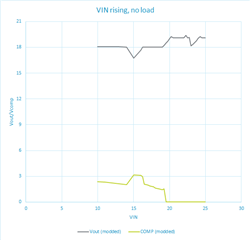Hi everyone,
We have a design that uses the LM5175 and are seeing issues with output regulation.
It is an 18V/5A design. 8 to 6V input.
With no-load in boost mode it operates nicely at 18V, on load the output drops volts, more at lower VIN.
With no-load when VIN transitions into the buck-boost region ~15V, when the VIN drops the output is locked to VIN +1.5V.
With no-load in boost it sits are 19V, on load it regualtes to around 17.5 to 17.75V.
Yes compared to the EVM board we are missing capacitors on ISNS, BIAS and VOSNS. To check I have removed these from teh EVM and it made little difference.

Also, the COMP pin clips to 3V during teh buck-boost region and it only operates in buck mode with COMP pin 0V. Why could this be?

Any thoughts or support in helping with this issue will be apprecidated.
Regards,
Humphrey

